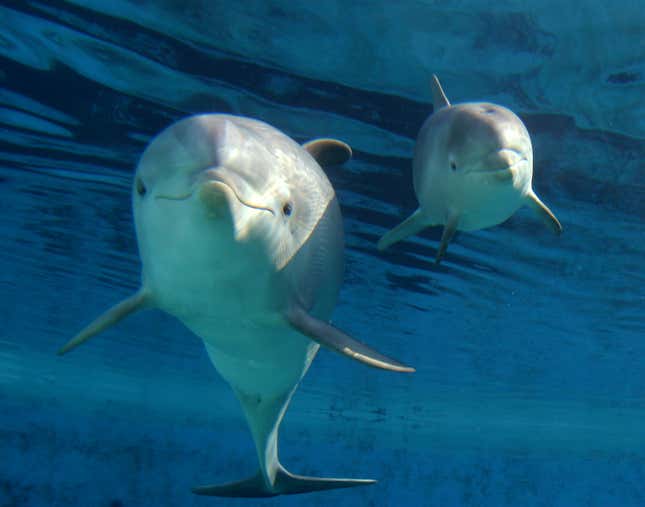The possibility of talking to animals has tickled popular imaginations for years, and with good reason. Who wouldn’t want to live in a Dr. Dolittle world where we could understand what our pets and animal neighbors are saying?
Animal cognition researchers have also been fascinated by the topic. Their work typically focuses on isolating animal communication to see if language is uniquely human, or if it could have evolved in other species as well. One of their top candidates is an animal known to communicate with particularly high intelligence: dolphins.
Dolphins—like many animals including monkeys, birds, cats, and dogs—clearly do relay messages to one another. They emit sounds (paywall) in three broad categories: clicks, whistles, and more complex chirps used for echolocation (paywall), a technique they use to track prey and other objects by interpreting ricocheting sound waves. Researchers believe these sounds can help dolphins communicate: Whistles can serve as unique identifiers, similar to names, and can alert the pod to sources of food or danger.
Communication is most certainly a part of what helps these animals live in social pods. But proving that dolphins use language—the way that you’re reading this article, or how you might talk to your friends about it later—is a whole different kettle of fish.
Language, in its most general terms, is a means of communication that uses signals that express individual units of meaning, which can be rearranged to pass along infinite amounts of information. To prove that language exists in any animal species, scientists would have to see evidence for discrete patterns of words that could be altered to mean different things. Even though dolphins have a fairly sophisticated means of communication, we still don’t have proof that they, or any other animal, have a limitless language. But then again, just because we can’t see it, doesn’t necessarily mean it isn’t there.
Across all species, animal communication shares some specific traits. As University of Cambridge zoologist Arik Kershenbaum explains it, animals produce signals designed to trigger “a response from the receiver that benefits the sender.” Wolves howl in order to mark their territory, and elephants may stomp to create vibrations beneath the ground to communicate across large distances. Birds use intricate songs to communicate the comparatively simple message to potential mates that they are available.
These signals can even be communicated across species. “You’d be foolish if you ignored the information that a tiger is growling at you,” points out Kelly Jaakkola, a cognitive psychologist and the director of research at the Dolphin Research Center in Marathon, Florida.

Humans, of course, use sounds and gestures to communicate, too. We wave to say hello and wink to signal a joke. Rubbing a friend’s back when she is distressed can be a way of showing solidarity or comfort. Laughter, crying, and screaming can cue in others within and even outside private conversations about the dynamic at play, and perhaps more importantly, if some kind of help is needed.
But these simple nonverbal signals, Kershenbaum argues, don’t make up a language. When we talk about language, what we really mean is the kind of communication that can express an infinite number of concepts. Human languages have units called morphemes, which are words, or parts of words, that can’t be broken down any further without changing their meaning. These can be words, or additions to words like prefixes or suffixes. Morphemes are represented by symbols, like sounds and shapes, and in the Deaf and DeafBlind community by gestures and touch.
In most cases, languages also have grammatical rules that enable us to communicate time with verb tenses, and to differentiate subjects and objects of sentences. This allows us to generate information about anything anywhere, like what we did last weekend or where we hope to one day go on vacation, and even things that don’t physically exist, like love or intelligence. Because of the vast number of words and sentence structures grammar allows for, we can talk about anything in any time in any place.
When animals signal to each other (or we give auditory, visual, or tactile cues) they’re usually conveying information about the situation at hand, Jaakkola says. On the other hand, “with real language, we actually don’t typically talk about the things that are going on around us,” she says. “It would be really odd if you and I were sitting together and I started naming things on the desk.”
But that is something animals like dolphins seem to do. Which is why, Jaakkola says, if we were trying to decipher if dolphins had “language,” we would probably start by thinking like an animal—looking to see if any sound units corresponded to an object at hand or an activity we could see happening simultaneous to the making those sounds.
If we could somehow identify objects being referred to repeatedly, we would need to see additional interaction about those objects in different contexts, “when those symbols are modulated or combined and that that changes the meaning,” Jaakkola said. Kershenbaum agrees: in order to prove that animal communication is actually a full language, he says, we’d somehow have to prove that animals were benefitting from back and forth communication in unlimited ways.
Take the sentence, “she fed him the fish.” Here, we’re talking about (presumably) two individuals interacting with a third object in the past tense. Now change the sentence slightly: “She will feed him to the fish.” Now, we’ve got the same number of actors in the sentence with the same basic action (feeding) but with a very different dynamic in a completely different time.
Since the 1960s, scientists have been collecting all kinds of evidence from dolphins about the possibility of their language. Once, a researcher even shared an apartment with a dolphin for 10 weeks to see if she could teach her aquatic roommate English (it did not go well). But as Kershenbaum points out, it’s hardly like we can go back to the animals with our findings and ask them what exactly they intended when they squeaked or squaked months earlier. Designing an experiment that could actually figure this all out might not be possible.
Plus, even if animals do have language, there’s no guarantee that we’d recognize it when we saw (or heard) it. “One of the pitfalls I think we have in a lot of studies, whether it’s in animals or aliens, is that we only have one example of languages,” Kershenbaum says. In other words, we have no way of knowing what we can’t understand.
Some researchers postulate that dolphins actually do speak a language through their echolocation, and that they speak through pictures generated by sound vibrations. This is a relatively new concept not yet widely accepted—but if it was true, it would go a ways in bolstering Kershenbaum’s point: the pictorial-vibration-based communiques would be so far from what we know as “language” that we don’t have anywhere near the ability to see, hear, or understand it in a meaningful way.
“If animals had language, I think you’d notice—they’d be doing the kind of things we do,” Kershenbaum says, referring to living in highly complex social structures, which language has enabled. Although, he adds, perhaps Douglas Adams, author of The Hitchhiker’s Guide to the Galaxy was right when he wrote:
“For instance, on the planet Earth, man had always assumed that he was more intelligent than dolphins because he had achieved so much—the wheel, New York, wars and so on—whilst all the dolphins had ever done was muck about in the water having a good time. But conversely, the dolphins had always believed that they were far more intelligent than man—for precisely the same reasons.”
Perhaps the dolphins are choosing to keep their native tongue a secret from us humans.
